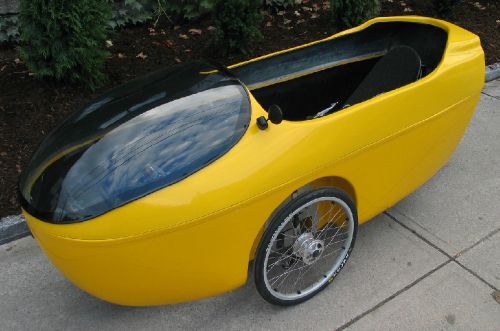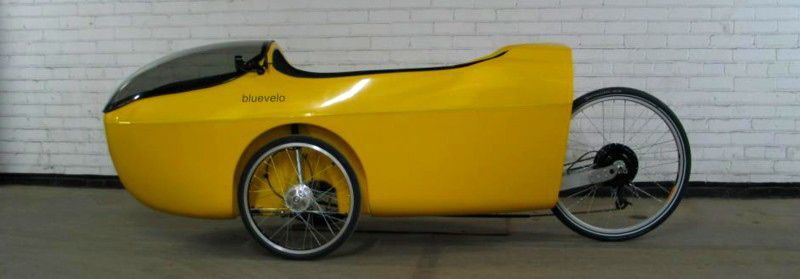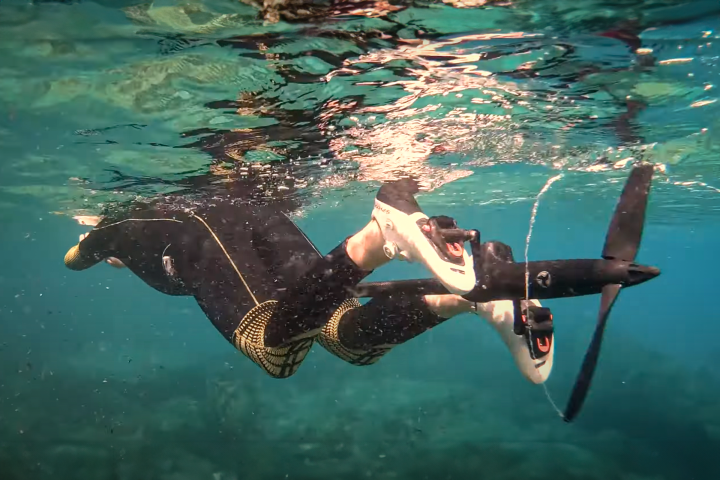If you take a recumbent tricycle and enclose it in an aerodynamic fuselage, what you end up with is known as a velomobile. The vehicles are significantly faster than bicycles on the flats and downhills, plus they offer more weather protection, but they do tend to be heavy – this can make hill-climbing quite an ordeal. Some manufacturers compensate for this limitation by offering electric assist motors as optional extras, although these just add even more weight, along with boosting what is already often a pretty high price tag. Toronto-based BlueVelo, however, has taken an interesting approach with its new Hornet velomobile. It was designed around its electric assist motor, which is included in the vehicle’s relatively low price.
Although BlueVelo began business primarily as an importer of European velomobiles, a year or so ago company founder Ray Mickevicius saw the need to create one for his young son.
“He has been around velomobiles most of his life, but wasn't able to ride shotgun with me any longer as he got bigger,” Ray explained to us. “As a result we talked about building a design that he could use himself for rides along our bike path system and in our local parks. We needed to improve the sight lines for him (due to his height, or lack of height), which is how we ended up with the bubble section on the nose. We also wanted to keep things pretty open around the cockpit area, so that he could talk to me, look around easily, and climb in and out ... We received a lot of positive feedback about the look of the design, so we started giving some thought to how we might make use of it in the future. Another project we had been considering was an electric assist runabout, and the two ideas just seemed to match up well.”

The resulting vehicle features a fiberglass body, full suspension, and a 37-volt 10 amp-hour lithium battery pack that delivers power to a 350-watt MegaMotion hub motor. This propels the Hornet to a top motor-only speed of 32 km/h (20 mph), which is the limit for electric-assist bicycles in Canada – riders, however, can push it beyond that speed by adding their own pedaling power.
Some of its other specs include the following:
- Adjustable seat
- 25 Amp controller and throttle control
- 9 speed 11-34 freewheel
- SRAM X7 shifter/derailleur
- Schwalbe Kojak (front) and Marathon Supreme (rear) tires
- 70mm Sturmey Archer drum brakes
- Side mirror
- 3 x 20" (406) wheels
Available extras include an upgraded motor, front and rear lighting, turn signals, a 26-inch rear wheel, and a kayak-like cockpit “skirt” for sealing out the rain.

Depending on the exact configuration chosen by the buyer, the Hornet weighs in at approximately 44 kilograms (97 lbs) with battery and motor included. The motor alone accounts for about four kilograms (9 lbs) of that weight. By way of comparison, the high-end motorless Go-One Evolution has a claimed weight of about 32 kg (70.5 lbs). Keep in mind that's the light end of the weight range for velomobiles, with many other models coming in significantly heavier.
If you live outside of Europe and wish to buy the imported-from-Germany Go-One, however, expect to pay at least US$12,980 – and again, that’s without a motor. Less exotic velomobiles still tend to start at no less than $6,000, and go up from there. A battery-and-motor-equipped Hornet, on the other hand, can be had for CDN$5,650 (currently on par with the U.S. dollar). Whether or not that is still too much comes down to what the vehicle is being compared to – it’s definitely pricier than a typical commuting bicycle, but it’s a lot less than a new car, and it won’t require gas, expensive repairs, or insurance.
An early prototype of the Hornet can be seen in action, in the video below.
Source: BlueVelo








